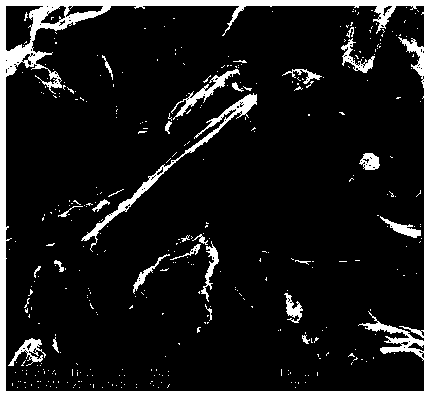Tibet snow lotus adsorbent and application thereof for rare earth ion absorption
A technology of rare earth ions and adsorbents, which is applied in the field of Tibetan snow lotus adsorbents, can solve the problems of snow lotus adsorption of rare earth ions that have not been reported, and achieve the effects of high recycling times, enhanced adsorption effect, and fast adsorption rate
- Summary
- Abstract
- Description
- Claims
- Application Information
AI Technical Summary
Problems solved by technology
Method used
Image
Examples
Embodiment 1
[0036] Wash the snow lotus flower body with deionized water for 3-4 times to remove the dust and soil on the surface; soak the cleaned materials in 1M HNO 3 , 0.1~4M NaOH, 1M H 3 PO 4 , 10wt% formaldehyde, 40% (v / v) ethanol and 10wt% (H 2 o 2 , keeping the solid-to-liquid ratio at 20g / L, soaking or stirring for 24 hours; obtaining snow lotus adsorbents treated with different treatment agents. Wash the surface treatment agent repeatedly with deionized water until the pH is neutral; after drying and crushing, pass through a 40-100 mesh sieve for storage.
Embodiment 2
[0040] Add 5mg of the adsorbent prepared in Comparative Example 1 to 30mL (maintain solid-liquid ratio 1:6g / L) of 0.1-40μg mL of pH 5 -1 Cerium ion (Ce 3+ ) solution, kept on a shaker at room temperature at 150 rpm for 2 hours, took the supernatant and filtered it with a 0.45 μm filter membrane, and then measured its Ce concentration by ICP-OES. And calculate its Ce adsorption capacity.
[0041] Cerium ion (Ce 3+ ) adsorption rate such as Figure 4 and5 shown. The pistil and flower body react to cerium ions (Ce 3+ ) have adsorption, but it can be clearly seen that the adsorption effect of the flower body is better than that of the stamen. The adsorption capacity of stamen is 24.62mg / g; but the adsorption capacity of flower body can be as high as 56.95mg / g. The adsorption capacity of the flower body is 32.33mg / g higher than that of the stamen, and the snow lotus flower body is used in the subsequent pretreatment.
Embodiment 3
[0043] Take 5mg of the adsorbent of Example 1 and add 30mL (maintain solid-liquid ratio 1:6g / L) of 5-50μg mL of pH 5 -1 Cerium ion (Ce 3+ ) solution, kept on a shaker at room temperature at 150 rpm for 2 hours, took the supernatant and filtered it with a 0.45 μm filter membrane, and then measured its Ce concentration by ICP-OES. And calculate its Ce adsorption capacity.
[0044] Adopt 1-1 formula, where:
[0045] q t = c 0 - c t m V - - - ( 1 - 1 )
[0046] q t : adsorption capacity corresponding to time (mg / g);
[0047] c 0 : Rare earth ion (Ce 3+ ) initial concentration (mg L -1 );
[0048] c t : Rare earth ion (Ce 3+ ) Concentration corresponding to time...
PUM
| Property | Measurement | Unit |
|---|---|---|
| adsorption capacity | aaaaa | aaaaa |
| adsorption capacity | aaaaa | aaaaa |
| adsorption capacity | aaaaa | aaaaa |
Abstract
Description
Claims
Application Information
 Login to View More
Login to View More - R&D
- Intellectual Property
- Life Sciences
- Materials
- Tech Scout
- Unparalleled Data Quality
- Higher Quality Content
- 60% Fewer Hallucinations
Browse by: Latest US Patents, China's latest patents, Technical Efficacy Thesaurus, Application Domain, Technology Topic, Popular Technical Reports.
© 2025 PatSnap. All rights reserved.Legal|Privacy policy|Modern Slavery Act Transparency Statement|Sitemap|About US| Contact US: help@patsnap.com



